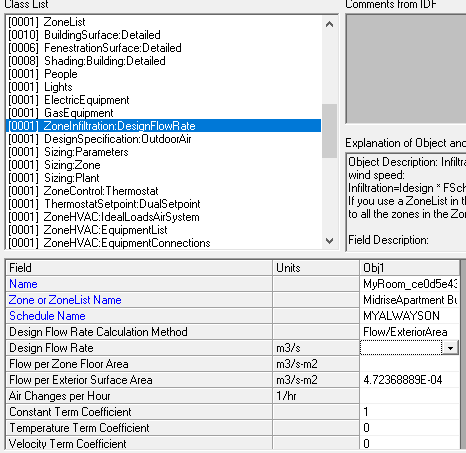@chris
I haven’t checked the model, or looked at the relevant EP docs in detail, but the various screenshots of the model she’s shared are consistent with the discrepency she is pointing out: the zone infiltration rate output varies throughout the simulation, even though all specified inputs should produce a constant, unvarying flow rate.
Are you sure that you’re looking at infiltration flow rates and not the energy gained/lost by I filtration?
Looks like it. This graph she shared earlier is titled as the zone ACH rate, and the actual values reflect the expected flow rate magnitude, (with exception that it’s not a constant):
Those temperature and wind coefficients that @charlie.brooker pointed out in the IDF schema will vary the flow rate depending on indoor+ outdoor conditions and these properties are exposed in the Ladybug Tools SDK but not on the Grasshopper components. So my guess is that it’s not them but you can make use of them if you find them important.
From the screenshot she shared of her IDF, those temperature/wind coefficients are already set to zero in her model, so they can’t be contributing to that varying flow rate. Admittently, there’s some ambiguity in the screenshot about the value of the Velocity Squared Term Coefficient for wind which looks like its not set explicitly, but the default is zero, so it shouldn’t be the cause of the variation:
You can also see there that the infiltration schedule is also a constant Always On, so that also can’t be a cause of the variability.
The AFN will also dynamically compute infiltration rates as @SaeranVasanthakumar points out. It you will only have this if you’re using the “HB Airflow Network” component.
Yeah, I was wondering if a possible explaination here might be the accidental use of the AFN, triggering a completely different infiltration calculation. At any rate, I can confirm this isn’t the case, I checked her script and its not in there.
So, if we go by the Design Flow Rate calculation used by EP (from the screenshot above it’s Infiltration=Idesign * FSchedule * (A + B*|(Tzone-Todb)| + C*WindSpd + D*WindSpd**2)), that output Infiltration should work out to a constant 0.4. I’m pretty curious, where the source of this variance coming from…







